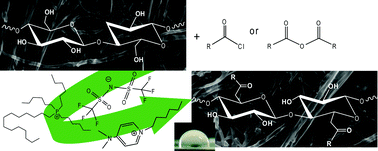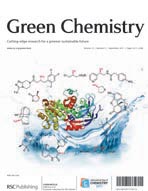The surface hydrophobization through heterogeneous chemical modification of bacterial (and vegetable) cellulose fibers with several anhydrides (acetic, butyric, hexanoic and alkenyl succinic anhydrides) and hexanoyl chloride suspended in an ionic liquid, tetradecyltrihexylphosphonium bis(trifluoromethylsulfonyl)imide, [TDTHP][NTf2], was studied. Furthermore, in the reaction with hexanoyl chloride, another ionic liquid, N-hexyl-4-(dimethylamino)pyridinium bis(trifluoromethylsulfonyl)imide, [C6N(CH3)2py][NTf2], was used instead of common organic bases as catalyst and to trap the released HCl. The analysis of the ensuing modified fibers by FTIR, XRD and SEM clearly showed that the esterification reactions occurred essentially at the fibers' outmost layers, not affecting their ultrastructure. The degree of substitution (DS) of the ensuing esterified fibers ranged from less than 0.002 to 0.41; and in all instances, the fibers' surface acquired a high hydrophobicity. This novel approach constitutes an important strategy in the preparation of modified fibers under greener conditions relaying in the use of non-volatile solvents.

You have access to this article
 Please wait while we load your content...
Something went wrong. Try again?
Please wait while we load your content...
Something went wrong. Try again?


 Please wait while we load your content...
Please wait while we load your content...